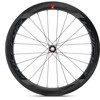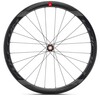Seeing Is Believing

A visit to the Fulcrum test laboratory, where quality and reliability take shape
We never joke about reliability. We dedicate obsessive levels of attention to this aspect. For us performance and results must be proven. We want proof and we want to share it with the riders that choose our products.
In order to do this we want to open the doors of our test laboratory and tell you something that we’ve never shared up to now. “Every wheel”, explains our Quality Manager, “undergoes extremely rigorous tests to verify the levels of performance and their long-term reliability, with instruments that can simulate the most demanding conditions. This is an important aspect that makes the difference in terms of reliability. It’s not enough to have top level performance. What is important is that these levels of performance are maintained over the long term”.
Is it true that you need at least two months in test labs to develop the environmental tests, functional tests and to verify the aesthetic aspects?
“Yes. Every wheel covers hundreds of kilometres with overloads that simulate the most demanding world championship courses. This applies to MTB wheels as well as road wheels”.
What is your aim?
“To achieve the highest level of performance and safety possible, and to maintain them over the long term. Our validation limits are nearly always much higher than those required by the type-approval standards”.
Can you explain how you test a product?
“There are various test levels and over the years we develop continuous upgrades to keep raising the bar of our objectives. Consequently also the machines and equipment are updated, to keep up with the evolution of the products and the increasing performance levels of the materials and production technologies. One example of this has been the increased heat resistance of carbon wheels used with rim brakes. This has been improved a great deal in the last few years, thanks to the use of high-performance resin systems”.
Do you only test in the lab?
“No. Once the laboratory tests are completed we begin long sessions on the road. Here we use three different types of special testers: amateur cyclists, professionals and semi-professional riders”.

What do the testers do out on the road?
“The testers in the field complete the laboratory experience, by reproducing in the real world all those conditions and aspects that cannot be replicated with machines. They also add a fundamental piece of the puzzle: the sensibility of the human being, which is essential to assess comfort, reactivity and handling: in other words riding experience. To take our products to their limits we also test them in the most demanding situations, such as Pro-level races, which give us invaluable feedback for our product development”.
How many kilometres do the wheels cover before entering the market?
“More than 20,0000 kilometres for each model, thanks to a team of over one hundred testers. This stage is all carried out whilst maintaining utmost confidentiality, without revealing anything when talking with the various riders, which is not always easy”.
Wheels designed for disc brakes undergo greater stresses. Are the tests more demanding too?
“Yes. The braking tests for disc wheels are much more rigorous and complex than for rim brakes. This is not only due to the exceptional braking forces reached by disc brake systems, but also because the wheel system is much more complex. The forces generated during braking affect the hub and the spokes too, unlike classic braking systems, which affect the rim”.

Safety and performance, without forgetting beauty. How do you test the long-term aesthetic performance of a wheel?
“We create environmental tests that reproduce the worst conditions that the wheel will undergo: mud, dust, UV rays, salt and water jets that replicate the effects of pressure washers. Quality and reliability must go hand in hand. This is a challenge that we set ourselves every day and that applies across the board, down to the smallest detail”.
Such as?
“The labels and the markings on the wheels undergo functional and reliability tests. For example, all our labels, from traditional adhesive stickers to water-transfers, must pass long sessions of artificial sun, in our QUV accelerated weathering tester and resist the chemical action of the most powerful detergents available on the market”.
Wheels are, after all, a fundamental element of the bicycle. Is it right for cyclists to pay so much attention to this component?
“Certainly. Wheels contribute to the aesthetics of a bike as well as its performance. In terms of their contribution to performance, wheels come right after the frame, and cyclists are fully aware of this. When choosing a new wheel aesthetics cannot be sacrificed for performance”.
So it’s a case of creating something that combines all these elements together?
“The tests are long and demanding because they need to guarantee the long life of the wheel. Our products must maintain their performance levels as well as their aesthetic characteristics, appeal and beauty over time. Every element requires the utmost attention: we have an obsessive care to the smallest details, which allows us to achieve products with long-term reliability. Products that make the difference when they are at their limit. Products for ‘good legs’, which will be used and appreciated for many years to come”.
The test laboratory is, in a nutshell, a living space, where there is constant interaction between work and passion, magic and pragmatism, man and machine. It never stops, not even at the weekends. The technicians work in shifts to ensure that everything is proceeding in the best possible way. There isn’t a minute to waste because there are always lots of materials and products to test. It is a constant challenge against the clock. Just like a race.
Full Article Source: Fulcrum Page


